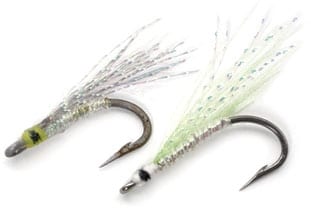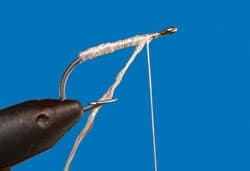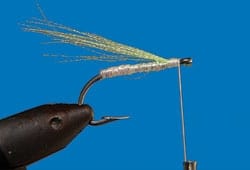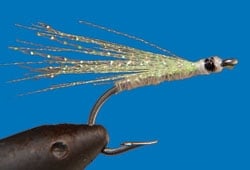
While bonefishing in the Bahamas not long ago, I witnessed an interesting feeding behavior. I was wading a spot that is fished frequently by self-guided anglers. The fish usually move slowly here, feeding in no hurry, and quite often they are tough to take.
I had already hit this place twice several days before with the usual tire kickers, but as I watched today, I witnessed a small pod of bonefish hitting a school of tiny baitfish, feeding in an aggressive style like a school of bluefish.
I shot a cast into the feeding fish, and two immediately rushed my shrimp pattern – but then they turned off. Quickly, I looked through my fly box, recalling that someone once told me about a small baitfish pattern that was effective in Honduras. I had several and tied one on just in time as two fish cruised across the flat.
The cast was short and wouldn’t have time to settle to the fish’s level. But it didn’t matter. One of the bones rose up and ate it on the run. Within an hour, I’d caught four more. Each time, the fish acted in the same manner – feeding in groups like schooling fish or cruising across the flat just below the surface. In each case, they hit aggressively.
Pleasant Surprises
This went on for almost a week, and my best success using this small fly occurred when I saw fish well up in the water column or quickly rushing across the flat. On several occasions, the fish actually broke the surface while feeding, and one time, about 20 were attacking a school of bait! The only times I’d seen bonefish fight to grab a fly was in extremely remote locations. Yet here were hard-to-fool, good-size fish doing the same.
A week later – once the fish stopped feeding so aggressively – they still took the fly. Not with the same recklessness they’d exhibited earlier, but the pattern still worked while others were refused.
What really sold me, though, was that this fly was producing in a location with big lockjaw bonefish. This particular flat commonly held bonefish that, at times, tailed in groups. Often a big fish would be tailing, creating a good mud, while several others milled about the perimeter. The best way to describe them would be “satellite fish.” Under these conditions, a crab or shrimp pattern should have been effective, but these fish seldom ate one. Yet I took several with the baitfish pattern – and each bite was aggressive.
There were surprises too. On one occasion, I cast too closely and spooked a big fish from the middle of a mud. As I watched it swim away, I was shocked when another suddenly bolted in and grabbed the fly! The fish that ate weighed around 8 pounds. I still wonder about the size of the bigger one.
This pattern goes against the grain of general thinking for bonefish. On light-colored flats with clear water, such as the ones I was fishing, bright fliesusually are effective in low light – not during midday.
I’ve heard of anglers using small streamers to fish in low light or when blind-casting channels, but for general fishing on clear, shallow flats with good sun, the use of baitfish patterns is not the norm. In fact, had I not seen the bonefish chasing bait, I would’ve never thought to use a fry pattern.
Simple, Effective and Versatile
I do not know whom to credit for this pattern, and I know there are other similar flies out there. What interests me, however, is how and why it works so well. It does not require a precise list of materials. I couldn’t even duplicate the fly in my box because I did not have the same material in my travel kit. But with some mixing and matching, I was able to tie some flies that looked similar and worked just as well.
Size and shape are important. The original pattern was about 1 inches long with a slim body. The fly sinks slowly and makes very little noise when entering the water. I did not fish it over grass beds but feel it would work well there, perhaps if tied inverted. If fishing in deeper water, you might consider adding a little weight to the body to get it down a bit faster.
This small-fly concept got me thinking too, and this past spring, I used some small sand-eel flies on stripers in knee- to thigh-deep water. When stripers cruise the backwater flats and are not feeding, they can be difficult. But these flies worked fairly well, and I plan to give them some serious time this spring.
In short, this small fly gives me another tool when the fishing gets tough. I tested it on only one Bahamian island, but it took fish in three separate locations, and I now plan to carry at least a dozen in my box when looking for the gray ghost.
I also expect that this pattern will be effective for other species that feed on small fry in clear, shallow water.
Next Page: Tying Instructions
Materials
Hook: Mustad 34007 or equivalent, No. 2 to 4
Thread: Flat nylon
Body: Bill’s Bodi-Braid or round body braid, pearl
Wing: Fluoro Fiber, lime green or light blue
Topping: Krystal Flash or Holo Chromosome Flash
Head Cement: Super Glue
Tying Instructions
| Step 1: Wrap pearl flash body material around hook shank, starting near the bend and stopping just short of the eye. Round wrap produces a thicker body. If using flat wrap, build the body up with several layers. |

| | Step 2: Begin forming the wing where the body material ends by tying in some lime-green or light-blue fine-fur material. I like Fluoro Fiber because it changes color slightly as the fly rolls, but any light hair-type material will work. |

| | Step 3: Blend a few strands of Krystal Flash or Holo Chromosome Flash in pearl or a light-green tint into the wing. Keep the wing sparse and thin. Add eyes to the head with a fine-point black Sharpie and then coat with Super Glue.|

|









